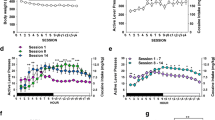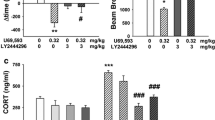Abstract
Objective
Previous studies demonstrated that the dynorphin/κ opioid system was up-regulated upon repeated cocaine self-administration. In the present study, we tested the hypothesis that increased cocaine self-administration with extended access was associated with increased activity of the κ opioid system in rats.
Materials and methods
Rats self-administered 0.5 mg/kg per injection of cocaine on a fixed-ratio (FR) schedule in either 1-h (short access, ShA) or 6-h (long access, LgA) sessions. After cocaine intake in the LgA rats increased to a maximum, the effects of κ opioid receptor antagonists and a partial agonist were tested on cocaine intake in ShA and LgA rats.
Results
Cocaine self-administration increased under FR and progressive-ratio (PR) schedules in LgA rats. Nor-BNI (15–30 mg/kg), a κ receptor antagonist, decreased cocaine intake in LgA rats under a PR schedule (ShA, +1.7%; LgA, −27.4% from baseline), whereas naltrexone (0.3–10 mg/kg) and SG-II-49 (0.025–0.1 mg/kg), a nonspecific opioid receptor antagonist and a partial agonist, respectively, decreased cocaine intake in both groups (PR data: SG-II-49, ShA −28.6%, LgA −19.8%; naltrexone, ShA −34.6%, LgA −11.8% compared with vehicle data).
Conclusions
The present study demonstrated that the antagonism of κ opioid receptors attenuated only the increased cocaine intake in LgA rats under a PR schedule, whereas the antagonism of µ and κ receptors decreased cocaine intake in both ShA and LgA groups. The data suggest that increased motivation for cocaine in rats with extended access may be related to increased κ opioid activity and may contribute to compulsive use.





Similar content being viewed by others
References
Ahmed SH, Kenny PJ, Koob GF, Markou A (2002) Neurobiological evidence for hedonic allostasis associated with escalating cocaine use. Nat Neurosci 5:625–626
Ahmed SH, Koob GF (1998) Transition from moderate to excessive drug intake: change in hedonic set point. Science 282:298–300
American Psychiatry Association (2000) Diagnostic and Statistical Manual of Mental Disorders, 4th ed. American Psychiatry Press, Washington DC
Bals-Kubik R, Herz A, Shippenberg TS (1989) Evidence that the aversive effects of opioid antagonists and kappa-agonists are centrally mediated. Psychopharmacology (Berl) 98:203–206
Beardsley PM, Howard JL, Shelton KL, Carroll FI (2005) Differential effects of the novel kappa opioid receptor antagonist, JDTic, on reinstatement of cocaine-seeking induced by footshock stressors vs cocaine primes and its antidepressant-like effects in rats. Psychopharmacology (Berl) 183:118–126
Butelman ER, Negus SS, Ai Y, de Costa BR, Woods JH (1993) Kappa opioid antagonist effects of systemically administered nor-binaltorphimine in a thermal antinociception assay in rhesus monkeys. J Pharmacol Exp Ther 267:1269–1276
Carroll ME, Lac ST (1992) Effects of buprenorphine on self-administration of cocaine and a nondrug reinforcer in rats. Psychopharmacology (Berl) 106:439–446
Comer SD, Lac ST, Wyvell CL, Carroll ME (1996) Combined effects of buprenorphine and a nondrug alternative reinforcer on i.v. cocaine self-administration in rats maintained under FR schedules. Psychopharmacology (Berl) 125:355–360
Corrigall WA, Coen KM (1991) Opiate antagonists reduce cocaine but not nicotine self-administration. Psychopharmacology (Berl) 104:167–170
Crawford CA, McDougall SA, Bolanos CA, Hall S, Berger SP (1995) The effects of the kappa agonist U-50, 488 on cocaine-induced conditioned and unconditioned behaviors and Fos immunoreactivity. Psychopharmacology (Berl) 120:392–399
Dum JE, Herz A (1981) In vivo receptor binding of the opiate partial agonist, buprenorphine, correlated with its agonistic and antagonistic actions. Br J Pharmacol 74:627–633
Ettenberg A, Pettit HO, Bloom FE, Koob GF (1982) Heroin and cocaine intravenous self-administration in rats: mediation by separate neural systems. Psychopharmacology (Berl) 78:204–209
Fox HC, Hong KI, Siedlarz K, Sinha R (2008) Enhanced sensitivity to stress and drug/alcohol craving in abstinent cocaine-dependent individuals compared to social drinkers. Neuropsychopharmacology 33:796–805
Frankel PS, Alburges ME, Bush L, Hanson GR, Kish SJ (2008) Striatal and ventral pallidum dynorphin concentrations are markedly increased in human chronic cocaine users. Neuropharmacology 55:41-46
Ghirmai S, Azar MR, Polgar WE, Berzetei-Gurske I, Cashman JR (2008) Synthesis and biological evaluation of alpha- and beta-6-amido derivatives of 17-cyclopropylmethyl-3, 14beta-dihydroxy-4, 5alpha-epoxymorphinan: potential alcohol-cessation agents. J Med Chem 51:1913–1924
Glick SD, Maisonneuve IM, Raucci J, Archer S (1995) Kappa opioid inhibition of morphine and cocaine self-administration in rats. Brain Res 681:147–152
Hanson GR, Merchant KM, Letter AA, Bush L, Gibb JW (1988) Characterization of methamphetamine effects on the striatal–nigral dynorphin system. Eur J Pharmacol 155:11–18
Hemby SE, Smith JE, Dworkin SI (1996) The effects of eticlopride and naltrexone on responding maintained by food, cocaine, heroin and cocaine/heroin combinations in rats. J Pharmacol Exp Ther 277:1247–1258
Horan P, Taylor J, Yamamura HI, Porreca F (1992) Extremely long-lasting antagonistic actions of nor-binaltorphimine (nor-BNI) in the mouse tail-flick test. J Pharmacol Exp Ther 260:1237–1243
Hurd YL, Herkenham M (1993) Molecular alterations in the neostriatum of human cocaine addicts. Synapse 13:357–369
Hyman SM, Fox H, Hong KI, Doebrick C, Sinha R (2007) Stress and drug-cue-induced craving in opioid-dependent individuals in naltrexone treatment. Exp Clin Psychopharmacol 15:134–143
Jones DN, Holtzman SG (1992) Long term kappa-opioid receptor blockade following nor-binaltorphimine. Eur J Pharmacol 215:345–348
Ko MC, Butelman ER, Traynor JR, Woods JH (1998) Differentiation of kappa opioid agonist-induced antinociception by naltrexone apparent pA2 analysis in rhesus monkeys. J Pharmacol Exp Ther 285:518–526
Koob GF (2008) A role for brain stress systems in addiction. Neuron 59:11–34
Koob GF, Le Moal M (1997) Drug abuse: hedonic homeostatic dysregulation. Science 278:52–58
Kosten TA, Marby DW, Nestler EJ (1991) Cocaine conditioned place preference is attenuated by chronic buprenorphine treatment. Life Sci 49:PL201–PL206
Kuzmin AV, Gerrits MA, Van Ree JM (1998) Kappa-opioid receptor blockade with nor-binaltorphimine modulates cocaine self-administration in drug-naive rats. Eur J Pharmacol 358:197–202
Land BB, Bruchas MR, Lemos JC, Xu M, Melief EJ, Chavkin C (2008) The dysphoric component of stress is encoded by activation of the dynorphin kappa-opioid system. J Neurosci 28:407–414
Mague SD, Pliakas AM, Todtenkopf MS, Tomasiewicz HC, Zhang Y, Stevens WC Jr, Jones RM, Portoghese PS, Carlezon WA Jr (2003) Antidepressant-like effects of kappa-opioid receptor antagonists in the forced swim test in rats. J Pharmacol Exp Ther 305:323–330
Marlatt GA (1985) Relapse prevention: theoretical rationale and overview of the model. In: Marlatt GA, Gordon JR (eds) Relapse prevention. Guilford Press, New York, pp 37–38
McLaughlin JP, Land BB, Li S, Pintar JE, Chavkin C (2006) Prior activation of kappa opioid receptors by U50, 488 mimics repeated forced swim stress to potentiate cocaine place preference conditioning. Neuropsychopharmacology 31:787–794
Mello NK, Mendelson JH, Bree MP, Lukas SE (1989) Buprenorphine suppresses cocaine self-administration by rhesus monkeys. Science 245:859–862
Mello NK, Mendelson JH, Bree MP, Lukas SE (1990) Buprenorphine and naltrexone effects on cocaine self-administration by rhesus monkeys. J Pharmacol Exp Ther 254:926–939
Miczek KA, Covington HE 3rd, Nikulina EM Jr, Hammer RP (2004) Aggression and defeat: persistent effects on cocaine self-administration and gene expression in peptidergic and aminergic mesocorticolimbic circuits. Neurosci Biobehav Rev 27:787–802
Mohamed MS, Larson DL, Takemori AE, Portoghese PS (1986) Activity of N-methyl-alpha- and -beta-funaltrexamine at opioid receptors. J Med Chem 29:1551–1553
Mucha RF, Herz A (1985) Motivational properties of kappa and mu opioid receptor agonists studied with place and taste preference conditioning. Psychopharmacology (Berl) 86:274–280
Negus SS, Mello NK, Portoghese PS, Lin CE (1997) Effects of kappa opioids on cocaine self-administration by rhesus monkeys. J Pharmacol Exp Ther 282:44–55
Pfeiffer A, Brantl V, Herz A, Emrich HM (1986) Psychotomimesis mediated by kappa opiate receptors. Science 233:774–776
Pliakas AM, Carlson RR, Neve RL, Konradi C, Nestler EJ, Carlezon WA Jr (2001) Altered responsiveness to cocaine and increased immobility in the forced swim test associated with elevated cAMP response element-binding protein expression in nucleus accumbens. J Neurosci 21:7397–7403
Rademacher DJ, Steinpreis RE (2002) Effects of the selective mu(1)-opioid receptor antagonist, naloxonazine, on cocaine-induced conditioned place preference and locomotor behavior in rats. Neurosci Lett 332:159–162
Ramsey NF, Gerrits MA, Van Ree JM (1999) Naltrexone affects cocaine self-administration in naive rats through the ventral tegmental area rather than dopaminergic target regions. Eur Neuropsychopharmacol 9:93–99
Redila VA, Chavkin C (2008) Stress-induced reinstatement of cocaine seeking is mediated by the kappa opioid system. Psychopharmacology (Berl) 200:59–70
Richardson NR, Roberts DC (1996) Progressive ratio schedules in drug self-administration studies in rats: a method to evaluate reinforcing efficacy. J Neurosci Methods 66:1–11
Romero DV, Partilla JS, Zheng QX, Heyliger SO, Ni Q, Rice KC, Lai J, Rothman RB (1999) Opioid peptide receptor studies. 12. Buprenorphine is a potent and selective mu/kappa antagonist in the [35S]-GTP-gamma-S functional binding assay. Synapse 34:83–94
Schenk S, Partridge B, Shippenberg TS (1999) U69593, a kappa-opioid agonist, decreases cocaine self-administration and decreases cocaine-produced drug-seeking. Psychopharmacology (Berl) 144:339–346
Schroeder JA, Hummel M, Simpson AD, Sheikh R, Soderman AR, Unterwald EM (2007) A role for mu opioid receptors in cocaine-induced activity, sensitization, and reward in the rat. Psychopharmacology (Berl) 195:265–272
Shaham Y, Erb S, Stewart J (2000) Stress-induced relapse to heroin and cocaine seeking in rats: a review. Brain Res Brain Res Rev 33:13–33
Shippenberg TS, Chefer VI, Zapata A, Heidbreder CA (2001) Modulation of the behavioral and neurochemical effects of psychostimulants by kappa-opioid receptor systems. Ann N Y Acad Sci 937:50–73
Suzuki T, Shiozaki Y, Masukawa Y, Misawa M, Nagase H (1992) The role of mu- and kappa-opioid receptors in cocaine-induced conditioned place preference. Jpn J Pharmacol 58:435–442
Takemori AE, Ho BY, Naeseth JS, Portoghese PS (1988) Nor-binaltorphimine, a highly selective kappa-opioid antagonist in analgesic and receptor binding assays. J Pharmacol Exp Ther 246:255–258
Todtenkopf MS, Marcus JF, Portoghese PS, Carlezon WA Jr (2004) Effects of kappa-opioid receptor ligands on intracranial self-stimulation in rats. Psychopharmacology (Berl) 172:463–470
Tomasiewicz HC, Todtenkopf MS, Chartoff EH, Cohen BM, Carlezon WA Jr (2008) The kappa-opioid agonist U69, 593 blocks cocaine-induced enhancement of brain stimulation reward. Biol Psychiatry 64:982–988
Turchan J, Przewlocka B, Lason W, Przewlocki R (1998) Effects of repeated psychostimulant administration on the prodynorphin system activity and kappa opioid receptor density in the rat brain. Neuroscience 85:1051–1059
Valdez GR, Platt DM, Rowlett JK, Ruedi-Bettschen D, Spealman RD (2007) Kappa agonist-induced reinstatement of cocaine seeking in squirrel monkeys: a role for opioid and stress-related mechanisms. J Pharmacol Exp Ther 323:525–533
Ward SJ, Martin TJ, Roberts DC (2003) Beta-funaltrexamine affects cocaine self-administration in rats responding on a progressive ratio schedule of reinforcement. Pharmacol Biochem Behav 75:301–307
Wee S, Specio SE, Koob GF (2007) Effects of dose and session duration on cocaine self-administration in rats. J Pharmacol Exp Ther 320:1134–1143
Acknowledgements
We gratefully acknowledge the technical assistance of Jovy Quiocho who was an undergraduate student of the University of California, San Diego. This is publication number 20047 from The Scripps Research Institute. This study was supported by the National Institute on Drug Abuse grant DA004398 (G.F.K.) and the National Institute on Alcohol and Alcoholism grant AA016029 (J.R.C.).
Author information
Authors and Affiliations
Corresponding author
Rights and permissions
About this article
Cite this article
Wee, S., Orio, L., Ghirmai, S. et al. Inhibition of kappa opioid receptors attenuated increased cocaine intake in rats with extended access to cocaine. Psychopharmacology 205, 565–575 (2009). https://doi.org/10.1007/s00213-009-1563-y
Received:
Accepted:
Published:
Issue Date:
DOI: https://doi.org/10.1007/s00213-009-1563-y




